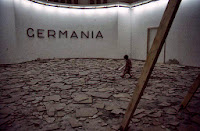I made my funding goal, with six hours to go. A backer bought a large piece that tipped my goal. I was with the engineers. After that, an additional two backers made pledges to bring the total funding to $10,165. Because I had one backer cancellation and another reducing the amount of their pledge, I stayed up to watch the seconds count down, keeping my fingers crossed. It felt great.
I was burnt to a crisp and needed to decompress. But today, I'm at it again, Skyping the LED guy to order the nine panels. He's sending me a PI (Proposed invoice, or RFP) tonight and I'll initiate payment. He says he can get me all nine units by the end of October; I say first week of November.
Also in the works is a new speaker. The original item is overkill for this project. Yes, it's nice, but I hadn't considered that there will be nine of them. While both venues are big, nine of the original units will blow the roof off them. I ordered a new, smaller one; I'll test it when it comes in at the end of the week. If I'm not confident I'll go back to the bigger one.
Wouldn't it be nice to have enough funds to outfit this project with those tiny BOSE speakers? However, I've already caught flack from "marketing expert" lookers-on that my KS goal of $ 10,000 was too high, as if they did any research to see how much things cost. Annoying, but I don't have time for their noise.
I already have the scans back so I'll work on those starting tonight. And, I'll start getting calls out to the riggers in NJ forwarded to me by ArtLab's director. I have to finish processing the sound. Other calls go out to Ithaca and the sound libraries in case they can recommend anything else.
And the engineers! Oy gevalt! (coming from me, trust me, it's sincere) The sensors are acting out, needing a longish reset time. They say can be fixed in the programming. Just in case, however, Dr. Marantz is looking at another sensor. They're both confident. I'm....well, let's say...nothing.
I have the sketches for the catalog; gotta firm up the copy from my curator friends. And then, I've gotta work on my backer's rewards. I'm finding nine frames, making a bunch of acrylic cases, the screen saver, uploading the wallpaper and ringtone.
I love this. I really do.
I was burnt to a crisp and needed to decompress. But today, I'm at it again, Skyping the LED guy to order the nine panels. He's sending me a PI (Proposed invoice, or RFP) tonight and I'll initiate payment. He says he can get me all nine units by the end of October; I say first week of November.
Also in the works is a new speaker. The original item is overkill for this project. Yes, it's nice, but I hadn't considered that there will be nine of them. While both venues are big, nine of the original units will blow the roof off them. I ordered a new, smaller one; I'll test it when it comes in at the end of the week. If I'm not confident I'll go back to the bigger one.
Wouldn't it be nice to have enough funds to outfit this project with those tiny BOSE speakers? However, I've already caught flack from "marketing expert" lookers-on that my KS goal of $ 10,000 was too high, as if they did any research to see how much things cost. Annoying, but I don't have time for their noise.
I already have the scans back so I'll work on those starting tonight. And, I'll start getting calls out to the riggers in NJ forwarded to me by ArtLab's director. I have to finish processing the sound. Other calls go out to Ithaca and the sound libraries in case they can recommend anything else.
And the engineers! Oy gevalt! (coming from me, trust me, it's sincere) The sensors are acting out, needing a longish reset time. They say can be fixed in the programming. Just in case, however, Dr. Marantz is looking at another sensor. They're both confident. I'm....well, let's say...nothing.
I have the sketches for the catalog; gotta firm up the copy from my curator friends. And then, I've gotta work on my backer's rewards. I'm finding nine frames, making a bunch of acrylic cases, the screen saver, uploading the wallpaper and ringtone.
I love this. I really do.







